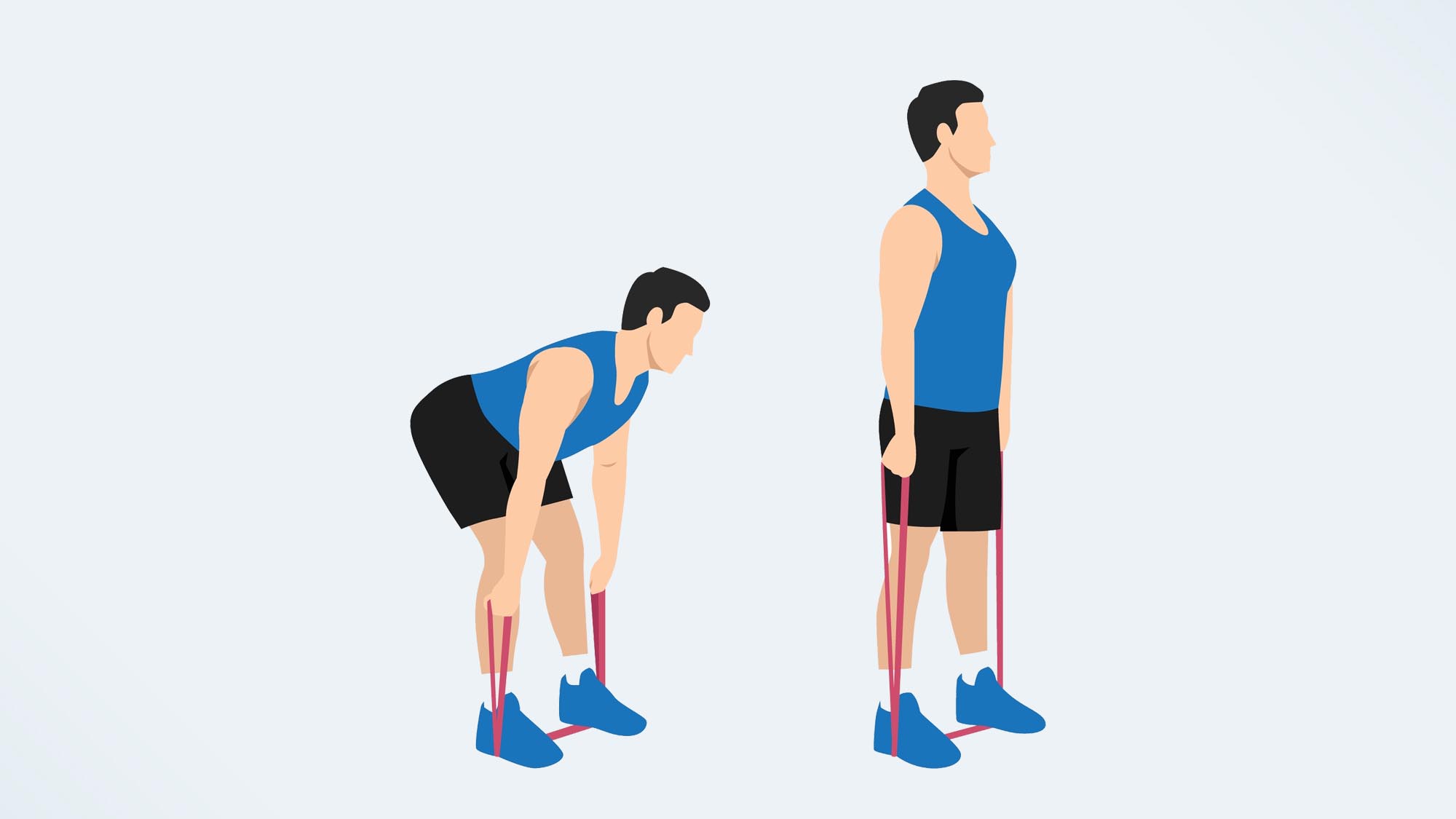I did resistance band deadlifts for a week — here’s what happened
Here's the benefits and what they can do for you

Resistance bands have been around in one form or another for more than 100 years. They’re light, portable, inexpensive, and highly adaptable, and you are less likely to injure yourself than you are when using barbells or dumbbells. Best of all, they look nothing like 19th-century chest expanders, which you are now only allowed to use if you have a huge, waxed mustache. If you’re looking to add a set to your home workout routine, we’ve found the best resistance bands on the market.
The deadlift is one of the most effective exercises in strength-training programs. It’s a compound weight move (it uses several muscle groups at the same time), so it’s very popular. If you’ve been to the weights area of a gym — and I totally get it if you haven’t — you’ve seen people perform the deadlift with a barbell, hinging at the hips to raise the weight from the floor. (We've got more information on how to do a deadlift with perfect form).
It’s highly unlikely you’ve seen anyone do it with a resistance band, because it doesn’t look as impressive. However, most people don’t have barbells lying around at home, so the resistance-band variation might just be the thing for you.
The deadlift is a great all-rounder. It works the glutes, the hamstrings, the hips, the core, and the back muscles, all the way up to the trapezius, which starts in the neck, fans across the shoulders and extends into the middle of your back.
How to do a resistance band deadlift
Before you start, choose a resistance band that suits your fitness, flexibility and strength level. Bands come in a range of sizes and strengths (they’re often color-coded), so pick one that will test you but allows you to complete your sets.
Begin by standing on a long resistance band (you need to be able to straighten from the hip-hinged position), with your feet hip-width apart and facing forward. Hold each end of the band — some have handles, but if yours does not, simply grip the ends tightly. You may need to try the move a few times to see how far down you wish to hold the band. The closer your hands are to your feet, the greater the resistance.
At this point, you should be leaning over, with a straight back and only a small bend in the knee. Your chest should be raised and facing forward, not down. This is an easy one to get wrong, so take your time.
Sign up to get the BEST of Tom's Guide direct to your inbox.
Get instant access to breaking news, the hottest reviews, great deals and helpful tips.
From this position, contract your core (to help stabilize your upper body), pinch your shoulders back slightly, and stand up smoothly and slowly, maintaining a straight back. You should feel the move primarily in your hamstrings, glutes and lower back. Return to the starting position by hinging again at the hips, always keeping that straight back and finishing with only that slight bend in the knees. This is one rep. Start off with three sets of 10 and see how you feel.

I did resistance band deadlifts for a week — here’s what happened
I’ve done this move with a barbell and dumbbells (check out the best adjustable dumbbells here), so I wasn’t sure what to expect from the resistance-band variation. For a start, you’re not lifting a weight; when you hold a barbell or dumbbell, you’re immediately aware of the heft of the thing, and you guide your movement accordingly. With a resistance band, you’re holding something you could fold and put in your pocket.
Day 1
On day one, I felt the move was too easy and because the band stretches, I was inclined to pull on it as I straightened. This is, of course, a mistake — I felt the move in my upper and lower back, but not, as expected, in my hamstrings and glutes. In short, my form was all over the place.
Day 2
On Day Two, I decided to use a full-length mirror to keep an eye on that form. This was (for me) a brilliant idea. I also dropped my arms lower to the floor — if you are doing this to add resistance, be careful it doesn’t come at the expense of increasing the bend in your knee, which turns the move into a squat. On sets two and three, I began to feel a deep, reassuring pull in my hamstrings, which are embarrassingly tight (because I’m a runner who doesn’t stretch enough; such people are often called… runners). I decided I had nailed the form. This is called hubris. Or stupidity.
Day 3
On Day Three, I was back to my blasé self, gliding through the sets without paying attention to the movement. A quick look in the mirror told me I was pulling on the band. With each of the challenges I’ve tried, I’ve noticed that if you let your mind wander, your body will go along for the ride and you’ll likely find your form suffers. This is a much easier move with a resistance band, even a thick one, but don’t tune out as you work through the sets.
Days 4 and 5
On Days Four and Five, I paid attention and felt the move where it should be felt, all the way to my upper back. To help me stay focused, I thought about each muscle being worked. This can be useful, but don’t get hung up on the hamstring because you might start wondering why the word refers to both the tendons and the muscles that make up the back of the thigh, and why don’t we use a Latin-derived word anyway, as we do for glutes or quads?* This is one sure way to lose your form. Which I did.
* The word can be traced to the Old English word, “hamm”, referring to the bend of the knee, and further back to old Germanic. It’s easy to see the connection between “string” and the tendons at the back of the knee, but why we also use the word “hamstring” to describe the muscles is a bit of a mystery. Laziness? And don’t get me started on the calf muscle…
Day 6
On Day Six, while my form was solid, I felt as if I was — literally — just going through the motions. On the final day, I decided to do a few sets with my dumbbells, for comparison. Even with a relatively light weight in each hand (12lb), I found I was getting more from the move and it felt natural. That said, I hadn’t previously used resistance bands to perform deadlifts, so perhaps this is just a matter of familiarity and personal preference.
Bottom line
The resistance-band deadlift is a good exercise if you’re new to the move. It’s also an exercise you can do almost anywhere, which I think is its greatest appeal. If you want to try it, buy a set a bands that have varying degrees of resistance, so you can increase the effort as you improve. However, I’m going to stick with my dumbbells for this one.
Looking for more workout inspiration? Here’s what happened when I did 30 Supermans every day for week, plus when I added 50 glute bridges to my morning routine.
John is a writer and editor based in London. He was worked for magazines such as Runner’s World, Men’s Health, Women’s Health and Cosmopolitan. A keen runner, what he lacks in ability he makes up for with enthusiasm and excuses.

